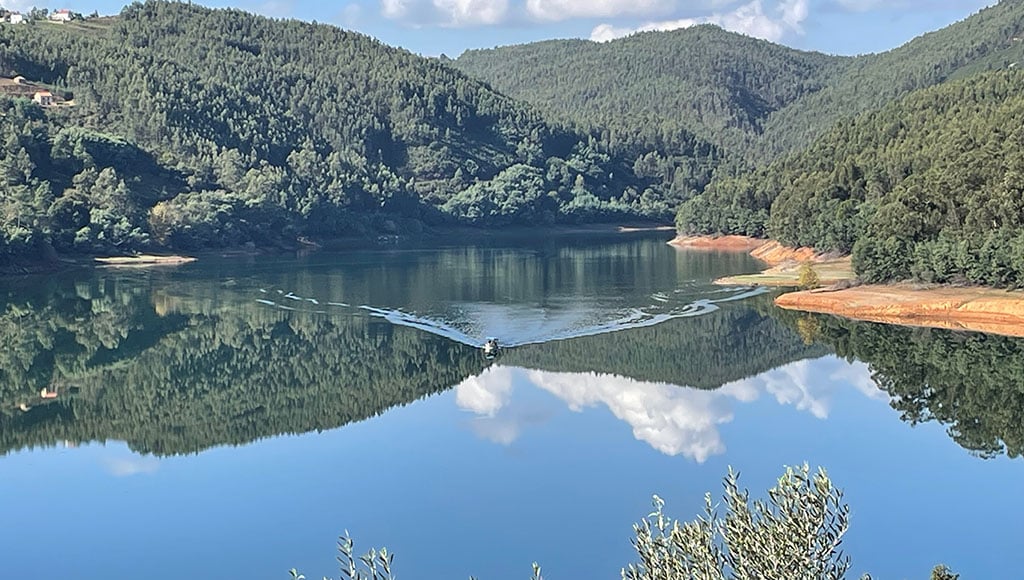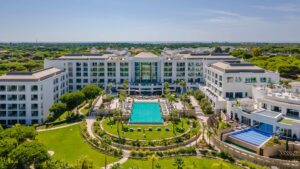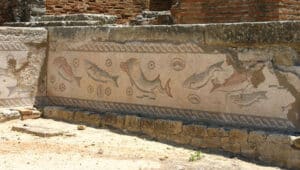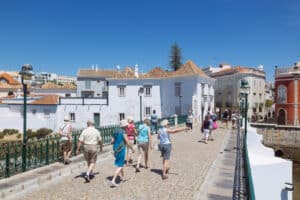A 12th century Templar tower is the start point of today’s trip which tracks a section of Central Portugal’s river Zêzere, whose full 214 kilometres starts high up in the Serra da Estrela and flows into the Tejo at Constância, Santarém.
With a clear November day bringing colour, warmth and light to our section of the river, the extraordinary tower at Dornes comes into view. This pentagonal lookout tower, perched on a promontory, was built on a Roman original and once formed part of the Tejo defensive system against the Moors.
Half an hour north-east of the Templar stronghold of Tomar, Dornes also is the only remaining place where traditional três tábuas river boats are made; the remaining artisans’ forebears were making these craft long before the Zêzere river was dammed in the 1950s, before which these river boats were essential transport for goods and passengers.
Heading up-river and crossing the ‘new’ bridge at Vale da Ursa, we find a boutique health retreat, Juicy Oasis, where guests detoxify while taking in the river view.
Near the entrance to this retreat sits the reception building for the Hotel Foz da Sertã, sadly both are long-abandoned and in a state of dereliction.
The Poirotesque, 44-room Hotel da Foz da Sertã was constructed in 1951 by businessman Júlio Martins to take advantage of a local thermal water source. When the river level rose after the construction of the Castelo do Bode dam, the hotel sat just above the new waterline, but customers had to get from the reception building to the hotel by boat, hardly ideal.
The business closed in the 1970s and the last owners sold it for redevelopment three years ago. Plans for a boutique hotel have been submitted to the Council and recent clearance of the surrounding forest bodes well for some serious development action.
The hotel location is stunning, and the area certainly will benefit from having a vibrant new business in the area, now with good road access rather than having to row.
The next dam upriver is the Bouça dam (1955) and its reservoir. This is not a leisure area; it was built purely for storing water for energy production.
There is an ‘EDP estate’ overlooking this dam which has some occupied houses and many empty ones that could be renovated. This estate originally housed EDP workers and their families while providing a communal swimming pool, playground, primary school, social centre and a clinic – unaffordable luxuries at the time for most locals.

There is a similar ‘EDP estate’ further upriver, near to the Cabril dam, Pedrógão Pequeno, where most of the original 1950s houses have been sold off and a community of first and second homeowners now thrives.
To develop the local short-term rental market in the area, the town of Pedrógão Pequeno recently has seen the rapid emergence of several AL tourist rental properties. This investment is welcome, as is the money and energy that rental properties bring to support local tourist activities.
The Cabril dam was completed in 1954 after a four-year construction period, officially is in the municipality Sertã, rather than Pedrógão Grande, despite the famous N2 road over the dam linking both municipalities.
A little way downstream from this huge dam is the ‘Philippine bridge’ built in the 17th century during the reign of Philip III of Spain, who ruled Portugal as Philip II. The structure replaced an earlier Roman bridge, the footings of which still can be seen on the steep sides of the gorge.
The Philippine bridge facilitated the passage of people and goods over the Zêzere River, many of whom will have stayed at the Albergaria de São Pedro in Pedrógão Grande, presumably gasping for refreshment after the steep climb. This historic property, originally a hospital and a hostel, is being remodelled as a private home after having many uses over the centuries, most recently as a taberna and small shop which closed during the Covid lockdown.
High above the Cabril reservoir, with astonishing views across the gorge to Pedrógão Grande, is the good value Hotel da Montanha where many local homeowners accommodate visiting friends and family rather than buying a property with extra bedrooms that get used only once a year.
Many tourism businesses are emerging and thriving in Central Portugal, notably along this section of the river Zêzere. Dornes continues to attract summertime crowds; the seasonal river beach and cafés at Cabril are increasingly popular; a lease is being sought for the long-closed Restaurante Largo Verde at Cabril; even the disused water station overlooking the reservoir has been demolished to make way for a water sports centre.
For the many visitors to Portugal who prefer to avoid crowds and packed leisure facilities, the calm and beauty of the Central Region has become a preferred destination.
By Paul Rees
The author runs Rural Properties, an innovative business that invests in the Central Region, buying, renovating and selling properties. For investment enquiries: www.rural-properties.com or contact info@rural-properties.com


























